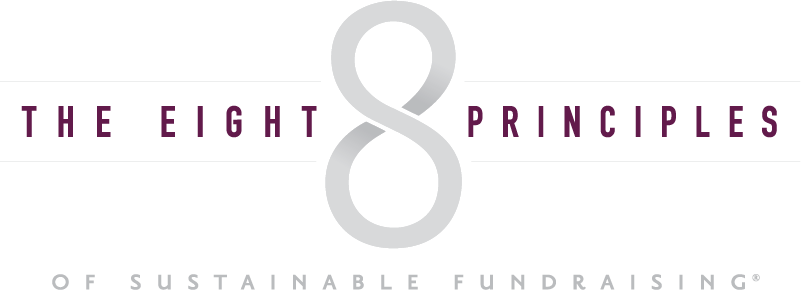Principle 4 of The Eight Principles®, is Learn & Plan™. First learn who your donors are then plan how to reach them. In this guest post, Craig Grella of Salsa Labs gives you practical action steps to know your donors then how to reach them.
Think back to the last time you tried to walk through a dark room at night without turning the light on. You probably bumped into furniture or tripped over clutter on the floor, reminding you that moving from point A to point B is so much easier when you can make a plan and anticipate your obstacles.
The same goes for fundraising. When you follow Principle 4 of The Eight Principles,® Learn & Plan™, your nonprofit can better understand who your donors are, what they value, and how to best inspire them to give to your organization.
That’s where the need for accurate donor data comes in. When you collect and store information about your current and prospective donors in your nonprofit CRM, it can help you identify giving trends that are unique to your organization, which can in turn guide your nonprofit’s fundraising efforts. The challenge lies in knowing how to use the data you collect.
To help, we’ve come up with this short guide to teach you all about leveraging your donor data. In it, we’ll cover the following tips:
- Plan data-driven fundraising campaigns.
- Identify major donors using thorough research.
- Deliver communications that resonate with donors.
- Take advantage of donors’ connections.
As you go through these tips, remember that it can be easy to feel overwhelmed by the many opportunities the information presents to your organization. Focus on using the data to deepen your relationships with your supporters and boost your fundraising so that you can use your time effectively to further your cause.
Plan data-driven fundraising campaigns.
Donor data can help you get the most out of your fundraising campaigns by providing you with the information you need to plan out a campaign that will give you the greatest ROI and help you stay within your allocated budget.
Simply collecting and storing data isn’t enough, though. According to this Salsa article on nonprofit key performance indicators (KPIs), you need to identify the metrics you want to measure and track among the data you collect. There are hundreds of possible KPIs you might track for your fundraising campaigns, so we’ll highlight just a few:
- Average gift size: No two donations are the same, but knowing the average donation size your nonprofit receives can give you an idea of how much value each donor represents to your organization. Your average gift size can help you plan out how many donors you need to target to meet your fundraising goals and what amounts you should be requesting.
- Donor retention rate: This refers to the percentage of donors who give a gift in two consecutive periods, typically measured year-over-year. This can help you identify if you need to do more to keep donors participating in your future campaigns.
- Fundraising ROI: This metric will help you figure out if you made money on the investment you put into your fundraising efforts. Fundraising ROI is typically used to compare campaigns or fundraising methods. The method(s) with higher ROI should be continued or expanded and lower (or negative) ROI campaigns should be minimized or ended altogether.
Because there are so many metrics you can keep track of, some nonprofits try to track too many, which can feel like herding cats. Make sure you work with your team to determine what you really need and want to know about your donors and what KPIs will be most useful in helping you get that information.
Once you’ve been tracking your data metrics for a while, you can use them to inform several aspects of your fundraising efforts, including:
- Budget: How much can you afford to spend putting your fundraising plan into action?
- Fundraiser goals: What donation total do you want to achieve with your fundraiser?
- Campaign timing/duration: When is the best time and season to roll out your campaign?
- Fundraising method: Should your fundraiser be an in-person event? An online peer-to-peer campaign? A product fundraiser?
- Marketing and communications strategies: How can you best promote your fundraiser and make sure your donors feel invited to participate?
Using your donor data to inform your fundraising plans and communication strategy should ideally take a load off your organization’s shoulders. As you leverage your data, there will be fewer unknowns your team will have to deal with, allowing you to put your time and effort into executing your plan rather than throwing it together as you go.
Identify major donors using thorough research.
Did you know that nearly 80% of nonprofit funds come from just 20% of donors? This means it’s well worth it to invest some time in prospect research to identify who in your donor pool could be a major donor.
To conduct prospect research, you can rely on a consultant to do it for you, or you can do it on your own with the help of the right CRM software. Either way, you’ll have to identify some key metrics that signal who you can target to solicit major gifts. These metrics fall into two categories:
- Metrics that indicate willingness (or affinity) to give: To identify whether someone might be willing to give your organization a major gift, look at philanthropic indicators like past giving frequency, size of past donations, and the nature of their connection to your organization.
- Metrics that indicate ability (or capacity) to give: These include property ownership, corporate giving eligibility, past political giving, and stock ownership, which indicates that someone has wealth to share.
Once you’ve identified candidates for major giving, you should work hard to cultivate relationships with those people. Even major donors don’t want to feel like you’re only coming to them for their wealth. They too want to feel a connection to the organizations and causes they choose to give to.
Try meeting with them in person and following up regularly after your first time communicating with them. Make sure to invite them to your organization’s events, and, when you feel the time is right, graciously ask for a donation.
Deliver communications that resonate with donors.
It doesn’t matter how well planned your fundraiser is— without a solid communication strategy, your campaign could fall short of expectations. You should use your donor data to plan out how you’re going to get the word out about your campaign.
There are a lot of options when it comes to marketing your campaign:
- Social media (Facebook, Instagram, Twitter, etc.)
- Email newsletters
- Print materials (posters, brochures, banners, and flyers)
- Text messaging
- Paid advertisements
- TV and radio advertisements
- Word of mouth promotion
- Direct mail
You can use KPIs like email open rate or social media conversion rate to judge which methods of communication resonate the most with your target audience. Beyond optimizing for your audience as a whole, you can further personalize your communications by segmenting your donors by shared characteristics like engagement history, communication preferences, demographics, and relationship lengths. Grouping your donors into categories will allow you to craft messages that will deliver the right donation asks to the right people.
For example, you might notice that your older generation of donors tend to open your emails more often, so you might group them together and let that group know about your upcoming fundraiser through an email newsletter. Your younger donors may respond better to a TikTok video announcing your campaign, so you can gear your message toward them on that platform.
Instead of mailing a stack of fundraising postcards and crossing your fingers or posting on Facebook on a whim, using a data-informed donor segmentation strategy with the help of your CRM allows you to take a much more strategic approach to promoting your fundraiser. And donor segmentation isn’t just reserved for marketing your fundraisers. It’s also great for other situations, too, like figuring out how best to write donor appreciation notes or how to tell the world about your volunteer program.
Take advantage of donors’ connections.
Principle 5 of The Eight Principles® is Work from the Inside Out™, meaning you should spend your time cultivating relationships with the donors who are closest to your organization. While donor data can certainly help you get to know your current donors better, it can also prepare you to leverage those donors’ connections so you can expand your network.
People are often more willing to get involved with a nonprofit if someone they know and trust is already giving their time or money to that organization. That’s why your current donors’ networks are a valuable resource for finding more people who care about your cause.
In addition to prospect research, we have two suggestions for leveraging your data to find new donors and additional fundraising opportunities among your current supporters, including:
- Look at who your current donors’ employers are and raise awareness about matching gift opportunities. Nonprofits miss out on a lot of potential funding because their donors don’t know if their gifts are eligible for donation matching. Collect data on your donors’ employers to find out how many of your supporters’ companies offer gift matching. 360MatchPro’s list of matching gift companies features several popular companies that offer these programs to their employees, so your donors can see if they work for any of them and claim extra money for your organization.
- Host peer-to-peer fundraisers. During a peer-to-peer campaign, your current supporters use a peer-to-peer fundraising platform to create their own campaign pages promoting your cause. Then, they share those pages with their family and friends, encouraging them to donate. Peer-to-peer fundraisers are extremely effective in bringing in new donors for your cause, because, as we mentioned above, people trust the people they know. If they see a friend having a positive experience with your organization, they’ll be more likely to get involved, too. To maximize your peer-to-peer efforts, use your donor data to determine what communication method will inspire the most people to create campaign pages and what types of messages will be most effective for your participants to inspire donations.
As you start to expand your nonprofit’s reach and explore new donor possibilities, make sure you return to your data often. It can help you reroute your efforts when you get off course, and you’ll occasionally want to track new metrics as you bring in new donors.
With the donor data you collect and store in your nonprofit CRM, the possibilities for your organization are truly endless. Your data can inform all of your operations, but it can especially help you out when you’re working to raise the money that is so crucial to your mission. Take these tips in stride and learn how to use your donor data most effectively for your unique organization. It’ll pay off as you improve how you plan fundraisers and cultivate lasting relationships with donors. Happy fundraising!

Craig Grella is a Content Marketer at Salsa Labs, a premier software for growth-focused nonprofits that combines CRM and engagement software with embedded best practices, machine learning, and world-class education and support. In his role, he serves thousands of nonprofits and advocacy organizations across the U.S.



